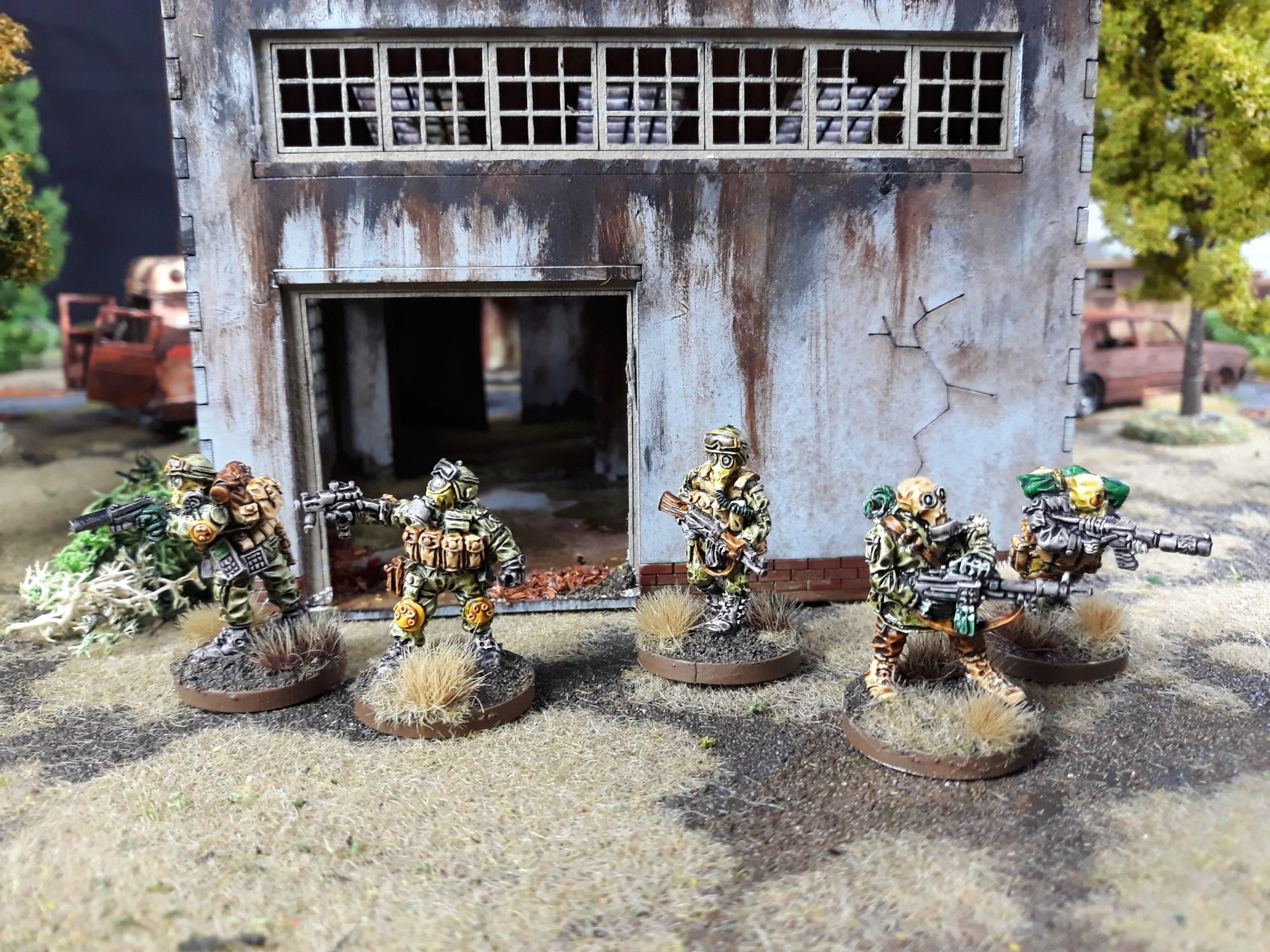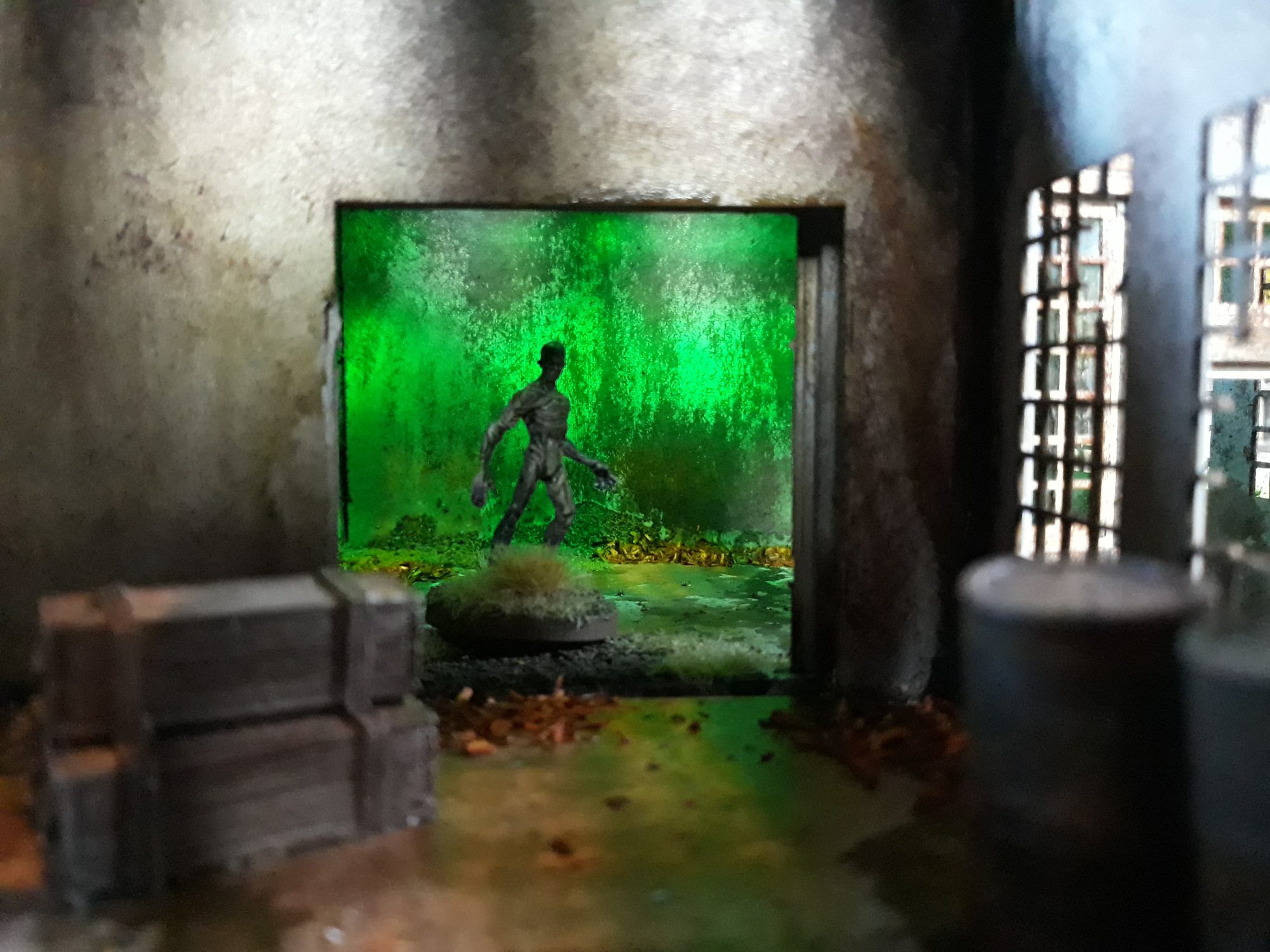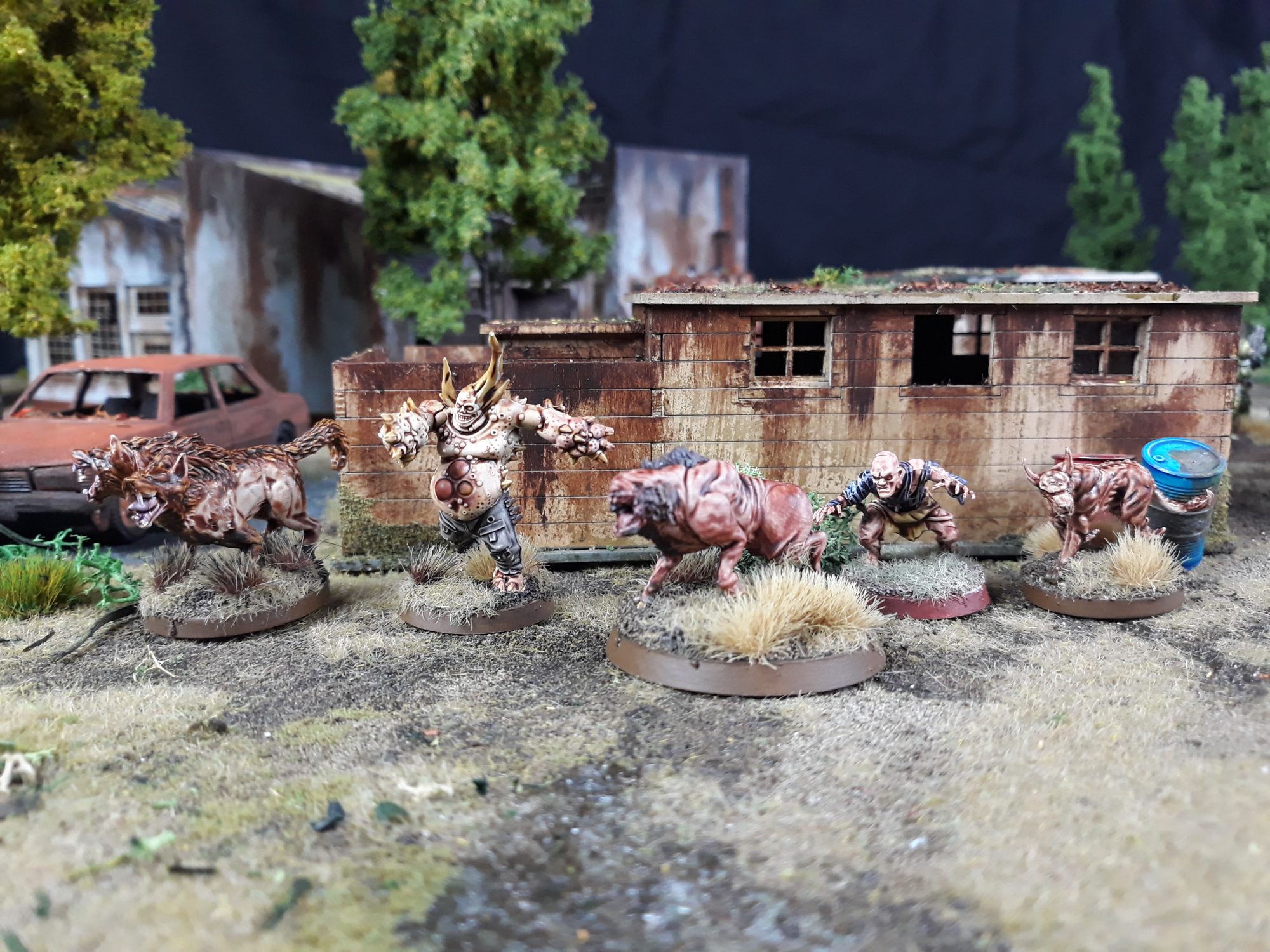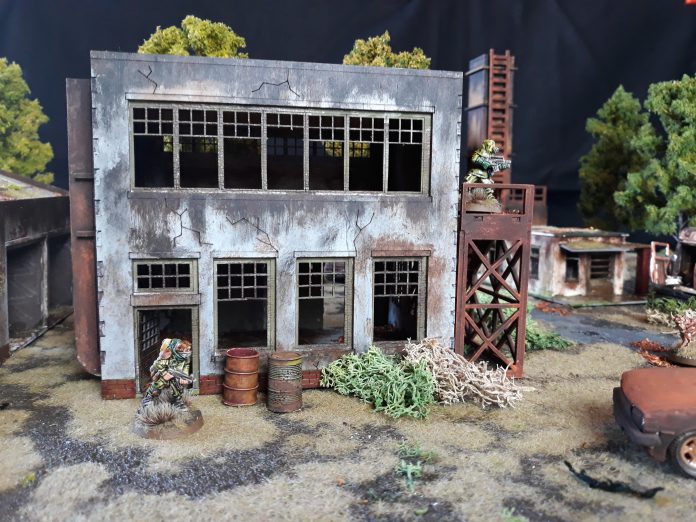For those who want to dive into miniatures gaming, or have short narrative games with a low model count, the market for miniature skirmish games is in a golden age. There’s a plethora of rulesets and settings to choose from out there depending on your taste, but if you’re a fan of the S.T.A.L.K.ER. or Metro 2033 video games series, you can’t get much better than Zona Alfa. People who like slow Russian movies – like the ones that inspired those games! – can also apply.
The setting should be familiar: the exclusion zone around Chernobyl has been compromised by strange events and you and your team of misfits are ready to loot the place. This will be severely hampered by bandits, mutants, anomalies and radiation. The ruleset is one of Osprey Publishing’s “Blue Books”, and if you’ve ever read one of those the format here will be familiar. At 64 pages it’s stuffed with rules, campaign play, some really nice pictures of minis, art of the Zone, and small, sordid tales to get you in the mood for some Stalking. As well as the core Zona Alfa game, there’s an expansion, Kontraband; I’ll be talking about both today, since Kontraband adds a bunch of great new options.
Getting started
The game is played on a 3×3 or 4×4 space depending on scenario, and lots of scenery is necessary as it is unforgiving for idiots who stand out in the open. So the more scenery, the better. You’ll need some models of course, and about ten per side should cover that if you want to run a gang of fresh-faced noobs.
There is no official model range. That being said, Chernobyl isn’t the only Zone in the world so you can easily proxy any modern miniatures or scenery you have in your collection. For the full-on S.T.A.L.K.E.R. vibe your best bet would be Lead Adventure models, which have put out a range that’s right at home in the Zone. I use some Spectre and Empress minis as well, or you can convert moderns and add some gas mask heads or respirators.
For all the nasty critters that roam the irradiated wastelands, you can use whatever you like or have handy. Zone Hostiles are a fairly loose group of opponents that will try to disrupt your operations in search of Stalker Juice, so if you’ve got a lot of giant spiders or zombies you can go wild with those. I’ve got a bunch of GW Poxwalkers as mutants, Mantic zombies and some Nolzur minis as random spawns.
Besides that, you’ll need a range ruler, and D10s. Yes, the ten-sided die will be used for shooting and looting so you’ll need 5 or 6 of those. You can also dust off your flamer template if you want to be that guy. ALSO: you measure from front to back! I can’t really recall any other game that does this but if you move in a straight line you can just plop a 6” range ruler down and move the model. Refreshing. This also means that the standard move of 6” is actually more like 7”. Did I mention that this game plays at a swift pace?
Getting the gang back together
Before playing you’ll need to construct a gang, and for that we’ll be using “Khrabost’ “, which rolls right off the tongue. Khrabost’ means mettle or courage, and translates to the tabletop as activations. You’ve got 12 to divvy up amongst your starting crew, and you can choose between 3 types of fighters. Your leader is a veteran and has 3 activations, so you have to divide the 9 remaining over other veterans (also 3), hardened guys (2 activations) or rookies (a measly 1). The better you are, the more gear you get so it’s possible to have a crew of 4 guys who rock a load of stuff but will probably be outnumbered. A bunch of veterans can be incredibly mobile with three activations (move-shoot-move) while a bunch of rookies will have to drink a can of refreshing Stalker Juice (methamphetamines and vodka) to get that sweet extra aim action before they shoot.
The combat ability, which covers both melee and shooting, gets worse the greener you are. You roll under combat ability on a D10, so a Vet with combat ability 6 will have a better chance than a rookie with 4. A roll of 1 is a natural success, which should give hope to players like me, who shouldn’t really be playing wargames with dice.

So how does this play out?
If you’re playing a one-off game, the first thing you want to do after assembling your crew is choose a scenario. You roll off with a D10 to decide initiative, and the winner can activate their first model. Each player alternately activates their models until everything’s had a go, then Zone creatures get to activate (usually by attacking your face). Every model can choose to move, attack (shooting and melee), aim, jump, rally, recover, reload… the basics of pretty much any skirmish game. Alert lets you spend two actions to go on overwatch, Use/interact covers the rest like opening doors or freeing a prisoner. Due to the narrative nature of the game some things can be adjusted to the scenario or to your liking, like using a couple of actions to defuse a bomb or break open a safe.
What it comes down to is a sandboxy feel where you can do anything that’s more or less realistically possible. The shooting action reflects this pretty well. You modify your shot by using red dots or scopes, but a shot is harder to take if there’s cover or the target is obscured.
Say a vet named Yuri is taking a shot at rookie Artyom. He’s got a basic combat ability of 6, and a red dot on his SMG that takes it up to 7. In theory he rolls 4 D10s (firepower of the SMG) and anything lower than an 8 is a hit. But Artyom is hiding behind bushes and a crate, so -1 for the soft cover of the bushes and another -1 for the soft cover of the crate. Cover stacks, so our friend Yuri’s combat ability goes down to 6. Like I said, you don’t want to stand out in the open!
When you do hit, there are armor saves. Depending on what you pulled from a dead stalker or bought in the stalls, this will drastically improve your chances of survival. Some weapons or ammunition are also better at penetrating armor. If you fail this save, you’re down unless you have a med kit. If you do make the save, you have to take a Will test to see if you have to change your underwear after getting plugged with a 7.62.
That’s basically all the math you have to do, and usually it comes down to common sense. It should be clear that this is not a game intended to be played in a tournament setting or mindset; the mechanics here need at least some agreement between you and your opponent about what “makes sense.”
It’s not only your opponent you have to watch out for. Oh no, the Zone is filled with stuff ready to tear heads off when you go poking around. Every time you investigate a zone of interest, monsters will spawn to ruin your day. Usually it’s less that idiot Ushanka you need to worry about because his gear is all busted, but the rad ghouls that come pouring out of their hiding place when you just spotted that shiny artefact.
Getting a campaign going
This game has campaign play at the forefront. Playing one-offs is fun, but the campaign phase really fleshes things out. You can upgrade your gear, stock up on vodka and other essentials, or hire new guys. When you construct your gang you can choose an affiliation which gives you benefits in this phase. Scientists get access to good gear, while Bandits can recruit rookies at a discount. They also get a free Molotov, so keep them at a distance. The Zone also grows deadlier as you progress in the campaign. More monsters will spawn when investigating, and they’ll have more actions which is hilariously awful.

Smuggling your Kontraband
Kontraband is the first expansion for Zona Alfa, and leans fully into the co-op/solo play. Instead of starting out with a starter band, you get 4 vets that either belong to the scientist or stalker faction. Each faction has its own types like smuggler, bounty hunter, field agent that have their own skills and specialisations. The reason you enter the Zone with a bit of a head start is that like Zona Alfa, Kontraband is just as deadly, and in some cases, very hard. Rookies have no place in the heart of the Zone.
Zona Alfa has optional Point Of Interest cards to spice up your game, and Kontraband expands on this to drive your game forward. You mark points on the board that generate events, and when searching the marker for loot, you flip the first card over. There are many effects this can have, some good, some bad, some weird, and mostly there’s loot to find. And you’ll want to salvage loot. Deep in the Zone you can’t trade at the stalls or with passing stalkers, and you’ll have to make sure you’ll scrounge enough food, water and batteries together, or else your stalkers will starve and their detectors and other equipment won’t work. You always have a chance to react to the events happening though, if you reveal a card you can shoot or run away (provided you get a good roll).
As if the chance that some mutant cannibal ghouls might eat your face off isn’t enough, you’ll have to sprinkle around some anomalies on your board as well. Luckily you can toss a bolt to find out what it is. Anomalies harbour the more lucrative artefacts, which you can also equip for some positive effects (and some minor radiation maybe).
This card mechanic drives the action, and works pretty well. When playing solo, I’ve noticed that game turns fade away and you’re playing out the story. I expect when playing co-op there’ll be some tough choices as well.
One thing that does happen is that your game experience is heavily dependent on the cards you draw. I had one game where I just breezed through the scenario as I had doable or positive effects and was pretty lucky with reaction rolls. Upping the terror level so more or harder monsters spawn in can fix that if you think it’s too easy. I suggest just enjoying a rather uneventful walk through the zone, and not getting my ass handed to me for a game and just picking up stuff I needed was a nice change of pace.
Like Zona Alfa, your games are enhanced by playing a campaign. Frankly, just playing one-offs doesn’t give you the full experience. Playing solo also lets you set your own pace, and pick up where you left off at a later time.

Verdict
I’m a sucker for small-scale skirmish stuff that lets me construct interesting scenery and models, so it’s got that going for it. It’s short and fast (also deadly) enough that you can easily squeeze in a couple games in an evening, so campaign play can be fast. It’s not superdeep, placing itself neatly on the narrative side of games, but fleshed out enough that you don’t have to houserule every 5 minutes.
The bad side is that it follows the Blue Book format so the rules are not laid out ideally for referencing rules. Other rulesets have the same problem, so I can’t really fault the author for this. Another thing I find weird is that there’s a WYSIWYG rule, ostensibly to keep people from hiding rocket launchers in their fanny packs, but since there’s no model range, and model ranges that you do want to use are metal, I find that a bit hard to justify in a narrative game. I can also imagine most people want to proxy some games before diving into a new range.
Kontraband only adds to the fun, and while it’s not the most polished book in the looks department the content is great and adds more stuff, skills, artifacts and scenarios to uncover in the zone. It also lets you play without interacting with other people if that’s your bag or some sort of worldwide event has you sequestered at home. It’s also one of the only solo games I genuinely enjoy.
There’s plenty of activity on the Stalker 7 and Zona Alfa Facebook groups as well, and nice ideas and scenery to look at. It may not be the next Necromunda, but it’s got a fun and dedicated following. The author is also a regular contributor and there’s plenty of stuff to find on his other games as well (which may get a review later).
In conclusion: Zona Alfa is fun, narrative, fast and cheap and gives you a chance to model something different than fantasy dungeons or the moon or whatever more popular rulesets out there use. Moderns players should definitely pick this up, since they’ve got everything handy already.


